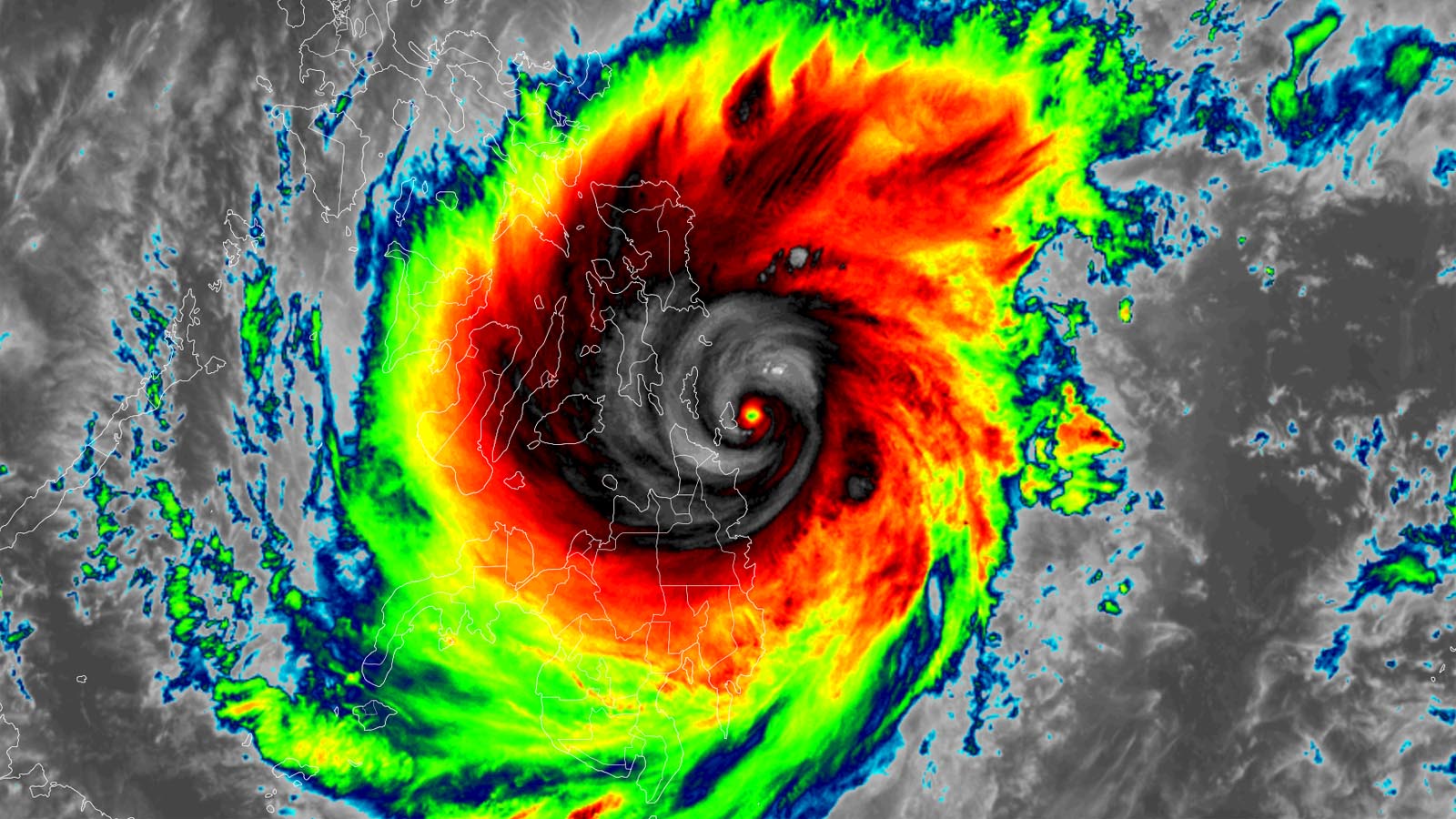The quieter-than-usual 2021 Northwest Pacific typhoon season saved its worst for last, with the final storm of the year, Super Typhoon Rai, a beast. According to the Philippine Atmospheric, Geophysical, and Astronomical Services Administration (PAGASA), Rai made landfall at 5:30Z (1:30 p.m. local time) December 16 on Siargao Island in the southeastern Philippines.
Rai was a category 5 storm with 160 mph winds at landfall, but was undergoing an eyewall replacement cycle at the time, and weakened to a category 4 storm with 150 mph 30 minutes after landfall. Rai went on to record multiple landfalls at category 4 and category 3 strength during the remainder of the day, as it plowed through the southern and central Philippines. It is too early to know the impact of the typhoon, but damage was undoubtedly severe.
Third Cat 5 landfall in the Philippines in the past two years
Landfalls by category 5 tropical cyclones are rare, since these storms are thankfully so few in number. No country on Earth sees more category 5 landfalls than the Philippines, though, which lies next to the largest area of deep warm waters anywhere on the planet. Rai is the third Cat 5 to make landfall in the Philippines in the past two years. Super Typhoon Chanthu passed directly over the municipality of Ivana on Philippines’ Batan Island (population 13,000) on September 11 when it was a category 5 storm with 165 mph winds. On November 1, 2020, Super Typhoon Goni hit the Philippines’ Catanduanes Island with 195 mph sustained winds, making it the strongest landfalling tropical cyclone in world recorded history.
Deadly December typhoons in the Philippines are not unusual
Strong typhoons can occur year-round in the Northwest Pacific, and the southern Philippines are no stranger to powerful December storms. Two December category 5 landfalls have occurred in the Philippines: Super Typhoon Bopha (called Pablo in the Philippines), which hit Mindanao as a category 5 storm with 170 mph winds on December 3, 2012, killing 1,900; and Super Typhoon Gilda, which hit Samar on December 18, 1959, with 160 mph winds, killing 23. There has been one other near-Cat 5 landfall: Super Typhoon Nock-Ten peaked as a category 5 storm with 160 mph winds at 3Z Christmas Day, before making landfall in the Philippines three hours later as a category 4 storm with 155 mph winds, killing 24 and causing over $1 billion in damage. Nock-Ten was the strongest landfalling typhoon ever recorded so late in the year. The only stronger typhoon recorded so late in the year over the ocean was Super Typhoon Hester, which peaked as a category 5 storm with 185 mph winds on December 31, 1952, about 1,000 miles east of the Philippines (Hester recurved out to sea without affecting any land areas).
Other recent deadly December Philippines storms:
Tropical Storm Washi (Sendong) killed 1,080 people on Mindanao’s north coast in December 2011.
Typhoon Kammuri (Tisoy) hit Luzon on December 2, 2019 as a category 4 storm with 140 mph winds, killing 17.
Tropical Storm Tembin hit Mindanao on December 22, 2017, killing 266.
A below-average year for Northwest Pacific typhoons
In the Northwest Pacific so far in 2021, there have been 23 named storms, 10 typhoons, and four major typhoons, with an ACE index of 192 (65% of average), according to the Joint Typhoon Warning Center. The 1991-2020 averages up to December 16 are 25 named storms, 16 typhoons, nine major typhoons, and an ACE index of 295. Thus, 2021 is below average in all respects, and well below average for everything except total number of named storms. This is to be expected in a year with La Nina conditions, since storms tend to form closer to the Asian mainland and spend less time over water, giving them less time to intensify. However, with two Cat 5 landfalls, 2021 is exceptional in that regard.
Prior to Rai, 2021 had been a much-below average year for deaths and damage in the Northwest Pacific, with only four landfalling typhoons, three of them at Cat 1 strength. The deadliest named storm thus far in the Northwest Pacific has been October’s Tropical Storm Kompasu, which killed 43 in the Philippines and one in Hong Kong. The most expensive was July’s Typhoon In-fa, which did $2 billion in damage, primarily to the Shanghai region of China.
Rai is the sixth Cat 5 of 2021
Rai is Earth’s sixth category 5 storm of 2021, putting the year near the 1990-2020 average of 5.3 Cat 5s per year. The other Cat 5s of 2021:
Super Typhoon Mindulle in the Northwest Pacific (165 mph winds, 920 mb central pressure, September 26);
Super Typhoon Chanthu in the Northwest Pacific near the Philippines (180 mph winds, 905 mb central pressure, September 10);
Super Typhoon Surigae in the Northwest Pacific near the Philippines (190 mph winds, 895 mb central pressure, April 17);
Tropical Cyclone Faraji in the southwest Indian Ocean (160 mph winds, 925 mb central pressure, February 8); and
Tropical Cyclone Niran in the South Pacific Ocean (160 mph winds, 931 mb central pressure, March 5).
Forecast for Rai
At 4 p.m. EST December 16, Rai was located near the western edge of the Philippines, headed west at 21 mph as a category 3 typhoon with winds of 125 mph. Rai is expected to turn more to the northwest and gradually weaken, skirting the coast of Vietnam on Sunday before dissipating south of China on Tuesday. Rai may not be the last tropical cyclone of 2021 for the Northern Hemisphere, though, since late December storms, as noted above, are not uncommon in the Northwest Pacific.
Bob Henson contributed to this post.
Website visitors can comment on “Eye on the Storm” posts. Please read our Comments Policy prior to posting. Comments are generally open for 30 days from date posted. Sign up to receive email announcements of new postings here. Twitter: @DrJeffMasters and @bhensonweather


